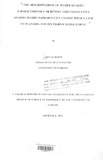| dc.description.abstract | This study is on the determination of water quality characteristics of runoff for consecutive storms within Nairobi's city centre with a view to planning for its proper management. The geographical location of the city of Nairobi is one of the major causes of recurrent floods which have affected [he city in the past one and a hal f decades. Increased surface runoff especially from the city centre is a result of reduced natural storage due to the artificial urban landscape. Management of this runoff which can take many forms, is an issue of great concern to urban planners and policy makers.
This study set out to investigate the volume of storm runoff generated from the city centre by a series of consecutive storms and to determine its chemical, physical and bacteriological qualities. The study also examined the variation of some of these quality parameters with each storm. A comparison of the water quality characteristics of runoff with guideline values for various uses (i.e domestic, agricultural and industrial) was then performed.
Both primary and secondary data were used in this study. The techniques of data analysis adopted in this study include Lloyd Davies formula, standard laboratory analytical procedures and techniques, graphical analysis and summary statistics. The random sampling procedure was used to pick the specific sampling pionts from where storm runoff samples were obtained. Ten samples were collected each from the selected sampling points within the first five minutes of each storm. composite samples were used inorder to minimize analysis costs.
From the analysis, it was found that the city centre, owing to its high runoff co-
efficient (0.9), generates large volumes of surface runoff during the rainy season. This vast quantities of storm runoff water from the city centre constitutes a potential resource which can be harnessed to supplement the existing water supply which is inadequate to meet the current demands.
Analytical results have revealed that the storm runoff water from the city centre is not as heavily contaminated as would have been expected. Furthermore, certain quality parameters such as cadmium, silver, molybdenum, nickel and selenium were not detected. Zinc, copper and mercury were only detected in the first three storm runoff samples indicating that the first few storms have a cleaning ("flush-off") effect on the city centre. The quality parameters which were found to exist in considerably high concentrations as to cause concern in the management of storm runoff water from the city centre are: iron, manganese, total suspended solids, total dissolved solids, oxygen demand, colour and turbidity. However, all these quality parameters can be regulated through conventional water treatment except oxygen demand (BOD and COD) which will require aeration. The bacteriological quality, though poor, can be improved through disinfection (e. g chlorination).
This study has recommended that the storm drainage system within the city centre should be redesigned in order to cope with the rapid changes taking place in this area which are continuously increasing the impervious area and that cleaning the drainage network especially during the dry spell should be enforced as a way of minimizing
clogging of the drains. Various methods of detaining the runoff water have also been
suggested. | en |

